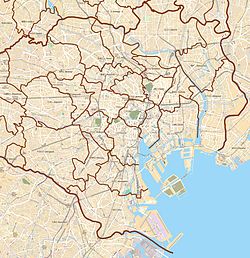Fukagawa, Tokyo
Fukagawa
深川 | |
|---|---|
District | |
 Fukagawa in the evening | |
| Coordinates: 35°40′33″N 139°47′46″E / 35.67583°N 139.79611°E | |
| Country | Japan |
| Prefecture | Tokyo |
| Area | |
• Total | 0.22 km2 (0.08 sq mi) |
| Population (August 2015)[2] | |
• Total | 3,843 |
| Postal Code | 135-0033 |
| [3] | |

Fukagawa (深川) is an area in Kōtō, Tokyo. It is one of the representative shitamachi of Tokyo. Formerly, it was a ward of the historical Tokyo City. In 1947, Fukagawa was incorporated into the ward of Kōtō, together with Suginami.
History
The Fukagawa neighbourhood is named after its founder, Fukagawa Hachirozaemon. Originally, parts of the Fukagawa district below the Eitai river (excluding Etchujima) had been part of the adjoining Pacific Ocean coastline; Hachirouemon developed these areas into viable land through the use of landfills.[4]
After the loss of roughly 60 percent of the city to the Great Fire of Meireki in 1657, the local shogunate ordered Buddhist temples on the north and west banks of the Onagi River and the east bank of the Sumida River to be relocated. During this time, the area had been mainly occupied by fishermen, with a population of just over 1000; as of 1695, the area became officially known as the town of "Fukagawa-Sagamachi".[5]
Following this, Fukagawa became known for its granary trade in rice and other grains; up until World War II, it was known as one of Tokyo's largest grain markets. In later decades, the construction of bridges along the Sumida River (previously prohibited for security purposes) allowed greater external access to the area, leading to Fukagawa becoming a gateway for the neighbouring town of Monzen-machi and a local red-light district.[5]
Fukagawa was an area particularly known for the brash and cutting-edge styles of the geisha who worked there, known as "haori geisha" or "tatsumi geisha", the former moniker ostensibly for having popularised the wearing of the haori - a kimono jacket - by women, when previously it had been worn solely by men.[6] Fukagawa may have been the location of the first female geisha in Edo,[7] as geisha had originally been male entertainers before transitioning to a majority-female profession in the early 19th century.[6] As a geisha district, Fukagawa had been in decline for many years, but following the move of Australian geisha Fiona Graham (known professionally as "Sayuki") to the area in 2015, has experienced a revival.[8]
Connections to Bashō
Fukagawa is known for its relations to the famous Japanese poet, Matsuo Bashō. In 1680, Bashō moved to Fukagawa. Here, he wrote one of his most famous poems, Frog Poem.[9]
35°40′37″N 139°47′49″E / 35.67694°N 139.79694°E
References
- ^ "平成22年 東京都区市町村町丁別報告". Retrieved 29 August 2015.
- ^ "江東区の世帯と人口" (PDF). Archived from the original (PDF) on 29 September 2015. Retrieved 29 August 2015.
- ^ "江東区役所の位置・庁舎案内". Archived from the original on 4 September 2015. Retrieved 30 August 2015.
- ^ Kamon, Nanami. Taking a Walk in Old Sumida and Koto [墨東地霊散歩] (in Japanese). ISBN 978-4-7917-6866-0.
- ^ a b "佐賀町界隈". Retrieved 8 September 2015.
- ^ a b Dalby, Liza (2000). Geisha (3rd ed.). London: Vintage Random House. pp. 277, 333. ISBN 0 09 928638 6.
- ^ "Tongue in Cheek: Erotic Art in 19th-Century Japan - The Gentrification of Yoshiwara". honolulumuseum.org. Honolulu Museum. Retrieved 23 May 2020.
- ^ "Keeping a tradition alive". Retrieved 25 October 2018.
- ^ "深川芭蕉庵跡". Retrieved 19 September 2015.


